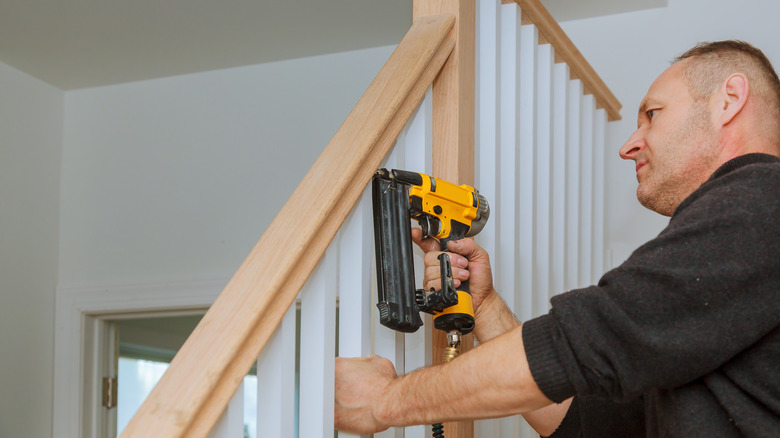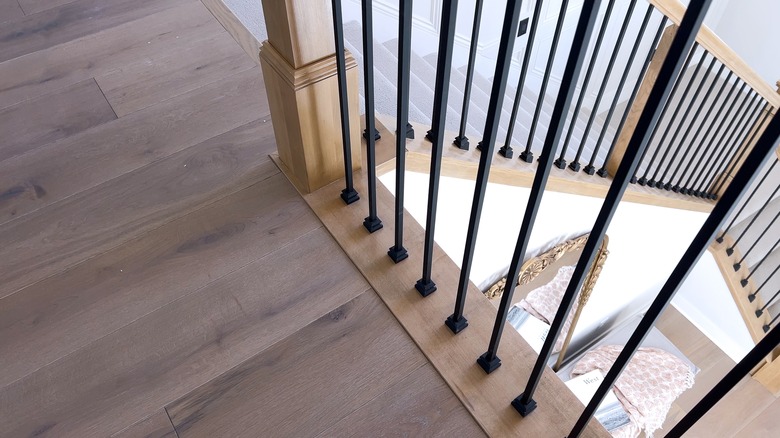If You DIY Balusters For Your Staircase, Beware This Fatal Mistake
When it comes to modernizing your home, there are so many different staircase makeovers you can do with any budget. Specifically, switching out old balusters to something fresh can be an inexpensive way to update the entire look of a space without changing anything else. In an attempt to save money on stair railing installation costs, you may be tempted to DIY this fairly straightforward project. But before you grab your tool belt, it is important to remember to double-check one major thing that could land you in safety or financial trouble in the future: proper baluster spacing.
If you are simply swapping an outdated baluster for a more modern alternative, it may not have dawned on you that changing the baluster profile or width could alter the spacing between the balusters. With very strict requirements for the maximum gap between balusters, your seemingly simple switch could send your DIYed railing out of code. These requirements are in place to ensure the railing has properly spaced weight support and complies with safety guidelines. Be sure to properly calculate the maximum legal baluster spacing before diving in to ensure you keep your home safe and investments in the black.
How to calculate proper baluster spacing
United States building codes require a maximum gap of no more than four inches between balusters. More specifically, inspectors use the 4-inch sphere rule, meaning a 4-inch diameter ball should not be able to fit through any part of your railing. Yes, they carry one around to test! However, if new balusters are your only project, it is unlikely that you'd require a permit/inspection (always double-check local building codes).
To use this 4-inch rule to determine your max baluster spacing, grab a tape measure. All baluster spacing measurements will be done "on center," meaning the placement will be determined based on the center point of the baluster. Measure the width of your baluster and divide it in half to calculate the distance from the centerpoint to the outer edge. For balusters that vary in width, use the narrowest point for calculations. Adding together that half measurement, the max 4-inch spacing, and another half measurement will get you to the center of the next baluster. For example, if you have a 2-inch wide baluster, half would be one inch to the center point. One inch plus a 4-inch gap plus another 1 inch would bring you to a total spacing of no more than 6 inches from one baluster center to another. If your current measurement is less than this, proceed! If it is more, you will need to select a wider baluster or completely change the spacing of all holes.
Do I really need to follow the four inch sphere rule?
Even though you may not require an inspection right now, it is important to keep this 4-inch rule in mind when DIYing your baluster upgrade for two reasons: safety and resale. The reason the guideline exists is because a 4-inch sphere is about the size of a baby's head. In an effort to prevent a child from getting their head through and potentially stuck (or worse, letting them go completely through), the rule helps make sure your stairs are child-proof and safe. Even if you don't have children, in the event someone else's child visits, you don't want to have the worry or liability on your hands for a poorly DIYed railing.
The other reason to be sure to follow this rule is because, at some point, you may want to sell your home. And guess who's going to drop by with their cute little 4-inch sphere? That's right, our trusty home inspector. If a railing is not up to code, they will flag it as a violation. This means that a buyer can request that you fix the railing on your dime, negotiate a lower price to allow them to update it on their own, or even back out of the deal entirely. Either way, this puts you in a bad spot for something you've already spent time and money on, so do it right the first time with proper safety in mind.


